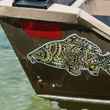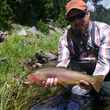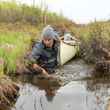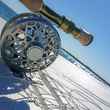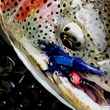The sound of rain on the roof is a sweet sound that I desperately miss during the time of year when all that can be expected from the sky is something frozen. That said, there's a time and place for everything and Wednesday is never a good day for rain. Neither is Thursday or Friday for that matter. All rain should fall on Sunday or Monday. Tuesday at the absolute latest. In that way all that water can run downhill by Saturday morning and the weekend, the blessed weekend, will find the streams well behaved and the trout in their usual spots.
The Hendrickson's have already been missed and the later hatches are getting started. There's an anxiousness that fills the mid-section as one looks for the intersection of flows and hatches and time off and sees little to be excited about. When a day free from labor hits and the water is the color of chocolate milk the rational mind says to tend to undone chores. In the grand scheme of things missing a day of fishing isn't the end of the world, but it's a Sunday afternoon and there's that bile that has accumulated and it has to be dealt with.



